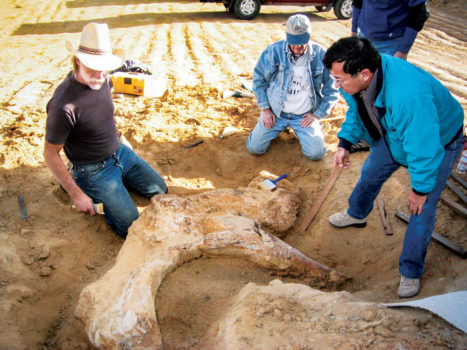
Colorado’s full of rocks. Some bear gold, diamonds or silver. Others burble oil, gas and water. A rare few record death itself.
These geological gallows occur in sedimentary rocks that dot some of our most inconspicuous scenery. Striped layers in such strata built up one-by-one as sediment accumulated at the bottom of valleys, lakes and oceans. As they were laid down, the layers recorded the changing conditions in ancient landscapes, often preserving signals of events that transpired. Geologists tease these clues out of rocks just like a dendrochronologist reconstructs ancient variations in rainfall from tree rings.

The K-T extinction occurred when a giant asteroid hit Earth. The photo shows the K-T boundary between the Cretaceous and Paleogene periods.
Such rocks aren’t economically useful. But they’re important because they allow us to understand how our planet responds to cataclysmic events, like massive kill-offs of the earth’s biota. And how ecosystems recover from them.
Colorado’s geology has something few other states have: evidence of the three biggest mass extinctions the earth has ever witnessed. During these intervals, our planet went from vibrant to nearly lifeless.
Every kid knows the third-biggest of these events. It’s the one in which a giant asteroid blasted our planet—launching a massive tsunami, causing acid to rain from the skies, and catapulting shards of volcanic glass across the globe. Oh, and it killed off the dinos as well as many of their seafaring brethren. This event, known as the K-T extinction, occurred 66 million years ago. It marks the boundary between the Cretaceous and Paleogene periods.
Colorado was the first place the K-T boundary was documented on land. Near Golden a geologist found a horn core from the latest Cretaceous dinosaur, Triceratops. Directly above it the dinosaur fossils disappeared, but the rocks bore early Paleogene plant fossils. This change signaled a radical turnover in the earth’s biota—early evidence of a massive terrestrial extinction event. This global wipeout was followed by another cool event—the diversification of mammals and blossoming of plants that ushered in our modern habitats.
The second-biggest mass extinction primarily impacted the oceans. It was a doozy—snuffing out corals, sponges, armored fish, and all the seafood that a time traveler to the Devonian period might have eaten. Here in the west, this end-Devonian event snuffed out marine communities the size of the Great Barrier Reef, as well as land-going ones. The cause was a one-two combo where oceans lost nearly all their oxygen, transforming them into something that might have stank like the black lagoon. Evidence of this mass extinction has been hiding in plain sight for millennia. Geologists recently identified the extinction in 360-million-year-old rocks exposed in Glenwood Canyon, on the Flat Tops, and along the stony battlements surrounding Ouray.
And the behemoth of extinction? It’s the P-T, which occurs at the boundary between the Permian and Triassic periods, 252 million years ago. It wiped out about 95 percent of the planet’s creatures. During the P-T our continents were rendered into barren, dusty Mars-looking landscapes. The oceans barely lapped onto continents, and when they did, they likely looked like an aquarium gone bad after a summer’s vacation. Slime and bacterial fuzz covered the seafloors. Salt was everywhere, making places like Colorado look like the original Dead Sea. Few creatures could tolerate these conditions, and those that did gave rise to the era of dinosaurs.
The cause of this “Great Dying?” We don’t know. It might have been from eruption of giant Siberian volcanoes, or it could have been from strange natural gas that gushed from the seafloor. New evidence about this event is forthcoming from Colorado, as geologists work to constrain the P-T in rather ugly rocks exposed along the Front Range and in mountainsides from Meeker to Aspen.
Extinction is a natural part of life. It brings balance to evolution. Studying it isn’t stressful, especially when it occurred long before we walked the planet.

Triceratops near Brighton, CO.
Yet when extinction impacts us, we worry.
Imagine scads of plants and animals going extinct. It’s actually happening right now. And not just in faraway rain forests, in bleached reefs, and in collapsed fisheries. It’s also happening in our beetle-ravaged forests and on our bison-less prairies.
How do we know if, when, or how these ecosystems will recover? One of the best ways to figure this out is to go back to times where critters endured cataclysmic events. By studying ancient extinctions, we can figure out how the survivors made it through their deathly gauntlet and what fostered re-establishment of new communities.
Unlike these ancient creatures, we can imagine the future. More importantly, we are like the Once-ler in Dr. Seuss’ The Lorax. We have the ability to learn from the past, to alter course, and to change our future.
James Hagadorn, Ph.D., is a scientist at the Denver Museum of Nature & Science. Suggestions and comments are welcome at jwhagadorn@dmns.org.


It is now apparent that – together with the iridium spike which has alternate explanations [volcanics or impact] – there is a also mercury spike at the K-Pg transition that could only have come from a volcanic source (Deccan Traps). Thus, the end Cretaceous extinction appears to be causally congruent with the earlier flood volcanics linked mass extinctions (eg. Siberian Traps – Putorana Plateau – Permian/Triassic boundary).
Why not a cyclical micronova of our sun?